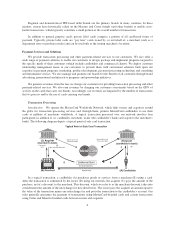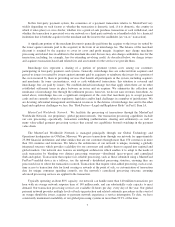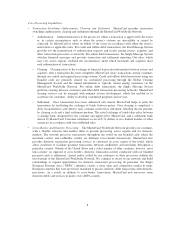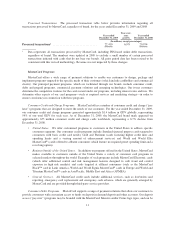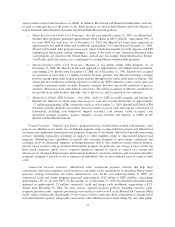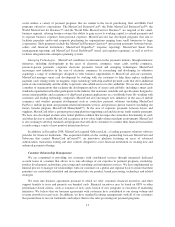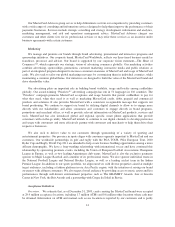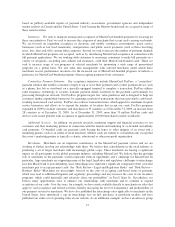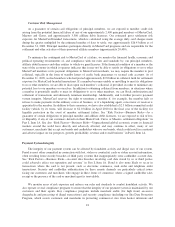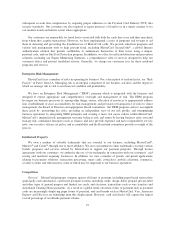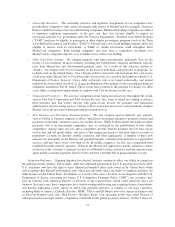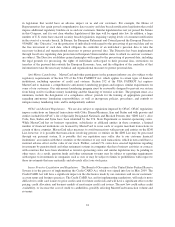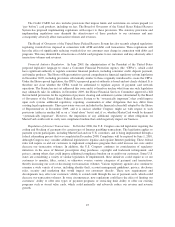MasterCard 2009 Annual Report Download - page 25
Download and view the complete annual report
Please find page 25 of the 2009 MasterCard annual report below. You can navigate through the pages in the report by either clicking on the pages listed below, or by using the keyword search tool below to find specific information within the annual report.based on publicly-available reports of payment industry associations, government agencies and independent
market analysts in Canada and the United States. Cards bearing the Maestro brand mark are accepted at many of
these same locations.
Initiatives. We seek to maintain unsurpassed acceptance of MasterCard-branded programs by focusing on
three core initiatives. First, we seek to increase the categories of merchants that accept cards carrying our brands.
We are focused on expanding acceptance in electronic and mobile commerce environments, quick service
businesses (such as fast food restaurants), transportation, and public sector payments (such as those involving
taxes, fees, fines and tolls), among other categories. Second, we seek to increase the number of payment channels
in which MasterCard programs are accepted, such as by introducing MasterCard acceptance in connection with
bill payment applications. We are working with customers to encourage consumers to make bill payments in a
variety of categories—including rent, utilities and insurance—with their MasterCard-branded cards. Third, we
seek to increase usage of our programs at selected merchants by sponsoring a wide range of promotional
programs on a global basis. We also enter into arrangements with selected merchants under which these
merchants receive performance incentives for the increased use of MasterCard-branded programs or indicate a
preference for MasterCard-branded programs when accepting payments from consumers.
Contactless Payment Solutions. Our acceptance initiatives include MasterCard PayPass, a “contactless”
payment solution that enables consumers simply to tap or wave their payment card or other payment device, such
as a phone, key fob or wristband, on a specially-equipped terminal to complete a transaction. PayPass utilizes
radio frequency technology to securely transmit payment details wirelessly to the payment card terminals for
processing through our network. Our PayPass program targets low value purchases and is designed to help our
customers further expand their businesses by capturing a portion of transactions that were previously cash-based,
resulting in increased card activity. PayPass also reduces transaction times, which appeals to merchants in quick
service businesses and allows us to expand the number of locations that accept our cards. PayPass programs
expanded in 2009 to include customers and merchants in 33 countries as of December 31, 2009, an increase from
28 countries as of December 31, 2008. As of December 31, 2009, more than 70 million PayPass cards and
devices were issued globally with acceptance at approximately 200,000 merchant locations worldwide.
Additional Services. In addition, we provide research, marketing support and financial assistance to our
customers and their marketing partners in connection with the launch and marketing of co-branded and affinity
card programs. Co-branded cards are payment cards bearing the logos or other insignia of an issuer and a
marketing partner, such as an airline or retail merchant. Affinity cards are similar to co-branded cards except that
the issuer’s marketing partner is typically a charity, educational or other non-profit organization.
Merchants. Merchants are an important constituency in the MasterCard payment system and we are
working to further develop our relationships with them. We believe that consolidation in the retail industry is
producing a set of larger merchants with increasingly global scope. These merchants are having a significant
impact on all participants in the global payments industry, including MasterCard. We believe that the growing
role of merchants in the payments system represents both an opportunity and a challenge for MasterCard. In
particular, large merchants are supporting many of the legal, legislative and regulatory challenges to interchange
fees that MasterCard is now defending, since interchange fees represent a significant component of the costs that
merchants pay to accept payment cards. See “Risk Factors—Legal and Regulatory Risks” and “Risk Factors—
Business Risks—Merchants are increasingly focused on the costs of accepting card-based forms of payment,
which may lead to additional litigation and regulatory proceedings and may increase the costs of our incentive
programs, which could materially and adversely affect our profitability” in Part I, Item 1A. Nevertheless, we
believe many opportunities exist to enhance our relationships with merchants and to continue to expand
acceptance of our cards. Over the years, for example, we have made available directly to merchants our rules that
apply to card acceptance and related activities, thereby increasing the level of transparency and predictability of
our payment system for merchants. We have also published the interchange rates applicable to merchants in the
United States, have introduced a cap on interchange fees on fuel purchases at petroleum retailers and have
published our entire set of operating rules on our website. As an additional example, we have an advisory group
15



